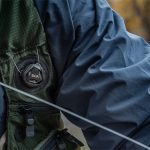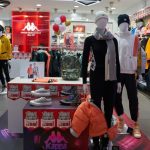Shares of Under Armour closed up about 12 percent on Thursday after the company reported better-than-expected earnings for its latest quarter while only slightly lowering its full-year guidance.
On a conference call with analysts, Under Armour interim president and CEO Colin Browne said, “In a highly challenging retail environment, we’re pleased that we’re able to deliver second-quarter results that were in line with our expectations. This demonstrates our team’s ability to operate through near-term volatility, staying focused on execution and delivering the world’s best sports performance products.”
In the fiscal second quarter ended September 30, earnings were $87 million, or 19 cents a share, against $113.4 million, or 24 cents, a year ago.
Excluding a $10 million legal expense related to ongoing litigation matters and a $5 million benefit from a tax valuation allowance release related to prior-period restructuring, adjusted net income was $92 million, or 20 cents a share, down 36.6 percent from $145 million. or 31 cents, a year ahead, but ahead of Wall Street’s consensus target of 16 cents.
Sales improved 1.8 percent to $1.57 billion, also surpassing Wall Street’s consensus target of $1.55 billion.
Excluding the negative impact of foreign currency, revenue was up 5 percent, according to Dave Bergman, CFO. The revenue gain came despite approximately five points of headwinds from proactive reductions and cancellations made late last year and early this year, due to COVID-19-related supply chain constraints.
By channel, wholesale revenue increased 4 percent to $948 million with increases in its distributor business partially offset by lower sales to the full-price and off-price channels. DTC revenue decreased 4 percent to $577 million due to a 9 percent decline in owned and operated store revenue partially offset by a 4 percent increase in e-commerce revenue, which represented 36 percent of the total direct-to-consumer business during the quarter. Licensing revenue increased 7 percent in the quarter to $33 million, driven by a solid performance from its North American business.
By region, North American revenue was down 2 percent, coming in at just over $1 billion for the quarter, with wholesale down slightly due primarily to the proactive order reductions and cancellations. North America DTC saw a “solid performance” in e-commerce that was offset by declines in its Factory House stores as late-arriving inventory and a challenging retail environment tempered sales.
International revenue increased 7 percent to $547 million, up 16 percent currency neutral. Within the international business, revenue increased 9 percent in EMEA, up 20 percent currency neutral. The EMEA gains were driven by growth in its wholesale business, partially offset by a decline in DTC. Bergman said on the call, “Following logistical challenges in the first quarter, positive operational progress helped us better serve strong demand.”
Sales rose 7 percent in Asia-Pacific, up 14 percent currency neutral. Said Bergman, “Despite ongoing COVID challenges and a relatively muted economic recovery in China, we saw growth in all channels, led by our southern APAC markets.” Sales increased 3 percent in Latin America, up 4 percent currency neutral.
By product category, apparel revenue decreased 2 percent in the quarter to $1 billion with strength in team sports offset by softness in training. Bergman noted that Under Armour did see strength in Rival fleece across all channels. In women’s, momentum continued to be seen in Infinity bras and Meridian leggings while Unstoppable pants saw strong sell-throughs in men’s in the quarter.
Footwear revenue climbed 14 percent to $376 million with positive results in all categories, led by significant strength in team sports with outstanding performances from Curry and Jet in basketball, Spotlight RM and Highlight cleats in American football and Harper cleats in baseball. Additionally, double-digit increases were seen in its outdoor and training categories. Said Bergman, “Our momentum and footwear, which we expect to continue for the balance of the year, is encouraging proof that our innovation is resonating.”
Accessories revenue fell 12 percent to $111 million due mainly to planned lower sales of sports masks compared to last year. Excluding sports masks, accessories were up at a low single-digit rate in the quarter.
Gross margin declined 560 basis points to 45.4 percent compared to the prior year, in line with expectations. The decline was driven by approximately 300 basis points from higher promotions and discounting, 100 basis points to supply chain impact mainly due to elevated freight costs, 70 basis points of various unfavorable channel impacts, 50 basis points of negative effects from changes in foreign currency, and about 30 basis points of unfavorable product mix due to the strength of footwear sales.
SG&A expenses were down 1 percent to $594 million as lower marketing expenses were partially offset by a $10 million legal expense related to ongoing litigation matters. In total, marketing expense in the second quarter was 9 percent of revenue.
Operating income was $119 million. Adjusted operating income excluding the legal expense was $129 million, down 31.7 percent against $189 million a year ago.
Inventory was up 29 percent to $1.1 billion. Bergman noted that comparisons were against leaner inventory levels in 2021. He said, “As supply chain deliveries continue to rebalance from recent disruption, we expect elevated inventory growth rates over the next few quarters with a peak in the high 40s, coming in our current third quarter, and then closing out our fiscal year in the mid-30 percent growth range. Looking at this from a different angle, going back and comparing it to pre-COVID 2019, would put both our estimated three-year inventory and revenue growth rate up about 19 percent, further demonstrating our inventory management strength in this environment.”
On the call, Browne said, elevated inventories, including late-arriving products across the active apparel sector, higher levels of discounting and promotions, and softer retail trends have slightly impacted the company’s outlook for the year.
Revenue guidance was lowered related to softer retail trends, particularly in North America, along with additional FX headwinds. Browne said, “Even so we’re holding the line on the gross margin outlook, which reflects our measured approach to maintaining brand health. We’re also being vigilant with SG&A, which we now expect to be slightly down as we prioritize investments towards areas with the highest returns and actively managing expenses.”
Browne also said the company remains in a strong cash position and inventories are in line with plans. He said, “The last two years have had us in a defensive position concerning inventory, but also left us with more out of stock than optimal service our business. As inventory approaches a more appropriate level for our size and with the composition of this inventory being mostly current and not aged, we feel confident and how we are managing with aspects of our business.”
Under Armour Executive Chair and Founder Kevin Plank on the call said Under Armour remains on track to announce a new CEO by year end. Patrik Frisk stepped down as CEO in June. He said, “I want to thank our Board for their incredible engagement in this process. And a special thanks to Colin for his strong steady and thoughtful leadership throughout as he is of course a serious candidate.”
Under Armour’s updated outlook for the fiscal year ended March 30, 2023 calls for:
- Revenue to grow at a low-single-digit percentage rate compared to the previous expectation of 5 percent to 7 percent growth due primarily to a more challenging retail environment and additional negative impacts from changes in foreign currency.
- Currency-neutral revenue is expected to be up at a mid-single-digit percentage rate compared to the previous expectation of 7 percent to 9 percent growth.
- Gross margin to decline 375-to-425 basis points, unchanged from the previous outlook.
- SG&A expenses to be down slightly against the prior year as the company manages costs amid uncertain market conditions.
- Operating income to reach $270 million to $290 million compared to the previous range of $300 million to $325 million. Excluding an expense related to ongoing litigation matters, adjusted operating income is expected to reach $290 million to $310 million compared to the previous range of $310 million to $335 million.
- EPS to be in the range of 56 cents to 60 cents a share compared to the previous expectation of 61 cents to 67 cents. This includes a 28 cents benefit related to a tax valuation allowance release expected to be realized during the fiscal year. Of this $0.28 benefit, $0.16 is related to prior restructuring. Additionally, there is a $0.04 negative impact from a legal expense related to ongoing litigation matters. Excluding net positive impacts of $0.12 largely related to the tax valuation allowance, adjusted EPS is expected to be in the range of 44 cents to 48 cents compared to the previous expectation of 47 cents to 53 cents.
- Capital expenditures to be approximately $225 million, unchanged from previous guidance.
Photo courtesy Under Armour
















